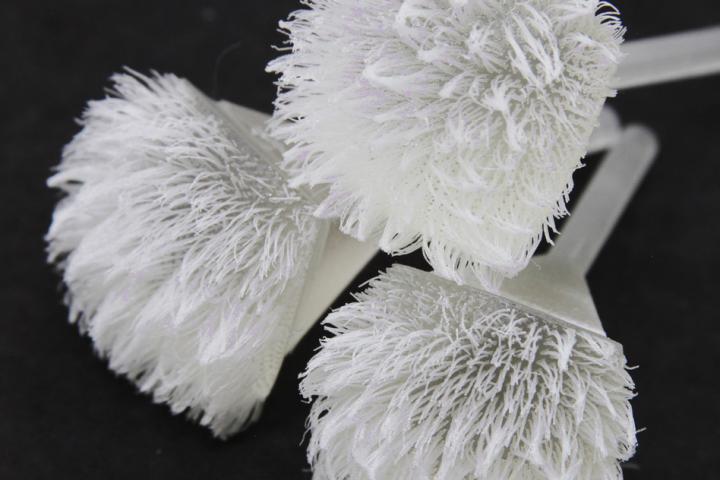Now researchers can 3D print thousands of hairs in minutes
Objects like hair, fur, and dense arrays of fine features typically require a lot of computational time and power to design and then print via additive manufacturing methods.
But now, researchers from MIT’s Media Lab have figured out a way to 3D-print thousands of hairs in just minutes, all while bypassing a major design step in 3D printing.
Instead of using conventional computer-aided design (CAD) software to draw thousands of individual hairs on a computer, which would take hours to compute, the team built a new software platform, called “Cilllia,” that lets users define the angle, thickness, density, and height of thousands of hairs, in just a few minutes.

By employing the new software, the researchers designed arrays of hair-like structures with a resolution of 50 microns — about the width of a human hair. They then designed and printed arrays ranging from coarse bristles to fine fur, onto flat and also curved surfaces, using an ordinary 3D printer.
The researchers suggest that the technology may one day even be used to print wigs and hair extensions. However, that is not their end goal. Instead, they’re trying to determine how 3D-printed hair could perform useful tasks like sensing, adhesion, and actuation.
To demonstrate adhesion capabilities, the team printed arrays that act like Velcro-like bristle pads. Depending on the angle of the bristles, the pads can stick to each other. For sensing, the researchers printed a small furry rabbit figure that was equipped with LED lights that illuminate when a person strokes the rabbit in a certain direction.
To determine whether 3D-printed hair could help move objects, the team created a weight-sorting table made from panels of printed hair with specified angles and heights. When a small vibration source shook the panels, the hairs were able to move coins across the table, sorting them based on the coins’ weight and the vibration frequency.
“It’s very inspiring to see how these structures occur in nature and how they can achieve different functions,” Jifei Ou, a graduate student in media arts and sciences. “We’re just trying to think how can we fully utilize the potential of 3D printing, and create new functional materials whose properties are easily tunable and controllable.”
The team looked for things to print that would test the limits of 3D printing — hair was the perfect subject.
“[Hair] comes with a challenge that is not on the hardware, but on the software side,” said Ou.
To 3D-print hair with existing software, designers would have to model hair in CAD and draw out each individual strand, then feed the drawing through a slicer program that represents each hair’s contour as a mesh of tiny triangles. The program translate each cross section into pixels that a printer could then print out, layer by layer.
According to Ou, designing an array just the size of postage stamp, comprised of 6,000 hairs, using this process would take several hours to process.
“If you were to load this file into a normal slicing program, it would crash the program,” said Ou.
The new method
That’s why the researchers opted to eliminate CAD modeling entirely. Instead, they built a new software platform to model first a single hair, then an array of hairs, and then to print arrays on both flat and curved surfaces.
“With our method, everything becomes smooth and fast,” said Ou. “Previously it was virtually impossible, because who’s going to take a whole day to render a whole furry rabbit, and then take another day to make it printable?”
Story via MIT.


Comments are closed, but trackbacks and pingbacks are open.